Tobacco Tales: Victorian Vaudeville and Edwardian Entertainment.
A closer look at two pipes from the National Pipe Archive.
By Kim Fisher, Visitor Services Assistant
The pipes that we have on display in the Tate Hall Museum come from the National Pipe Archive that is presently housed in the department of Archaeology at the University of Liverpool.
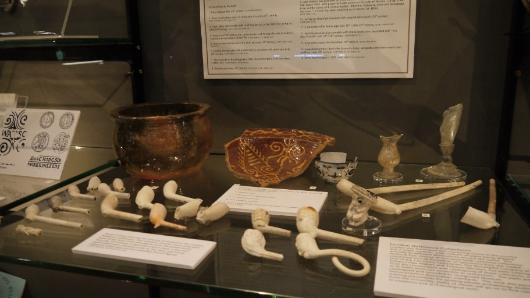
Some of the National Pipe Archive collection that is on display in the Tate Hall Museum, Victoria Gallery and Museum.
Why is the archive important?
For more than four centuries clay tobacco pipes were produced and consumed as an everyday part of life. It is now realised that their discarded remains provide one of the most powerful means of dating and interpreting archaeological deposits from the Tudor period onwards. They provide an important class of artefact that can be used to help define the emergence and development of social and cultural groups and the study of pipes can provide insights into the artistic, commercial and social aspirations of individuals and communities around the world.
Clay pipes were first used in Britain in the 16th century following the importation of tobacco from the Americas, early pipes tend to have small bowls as tobacco was relatively expensive within this period. However, economics and fashion changed the basic shape of the clay pipe, and pipes enabled the individual to express their own interests and hobbies.
As we can see from the display case in the Tate Hall, there were a lot of elaborate designs during the Victorian and Edwardian eras and these are the periods I will be focusing on in this article.
Tobacco Tales
Objects can have interesting stories to tell but they are not always apparent to a modern-day audience. In this article I would like to highlight two examples in particular that present similar themes linked to vaudeville acts, early silent films and also the comedy presented in Victorian and Edwardian family life by comic strips of the day.
These pipes provide a social commentary and tell us about Victorian and Edwardian fashions and interests but the characters represented on the pipes may be unfamiliar to a modern audience today. The following information will explain a little bit more about the characters and their stories and why the pipes were originally created.
Ally Sloper
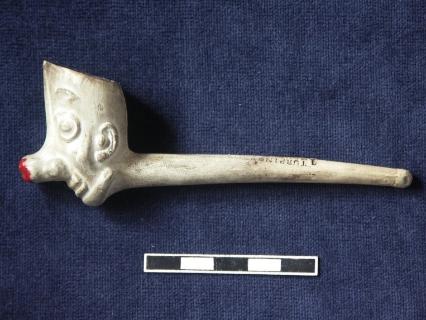
An Ally Sloper Pipe from the National Pipe Archive collection
This is an anthropomorphic pipe where the bowl of the pipe has been made to look like a character.
Ally (Alexander) Sloper was one of the earliest comic strip characters who appeared from 1884 and his name derives from slang at the time as an Alley Sloper was someone who would slip out the back door into an alley when the landlord called, in order to avoid paying the rent.
Mr Sloper also had a fictional family that included his wife Mrs Sloper, their showgirl daughter Tootsie, a son called Alexander, twin boys and a dog named Snatcher. The comic strips would depict the humour of Victorian family life including Sloper trying to avoid his wife just as much as his landlord.
The comic ‘Ally Sloper’s Half Holiday’ was written for the working class (Bailey, P. 1983, p. 9) and the half-holiday refers to the half day off given to workers on a Saturday and focused on many activities that working-class people liked to enjoy such as smoking, sport and the music hall culture.
Ally Sloper’s character also spread onto stage and screen and in 1887 Sloper appeared in almost every pantomime during that year (Banville, S. 2008, p. 158) and starred in several early silent films.
The magazines and performances launched Sloper’s character into an entertainment phenomenon and there was a lot of money to be made with merchandise. By sending in coupons from the magazine to the fan club called ‘Sloper’s Club’ you could have your very own Sloper tobacco pipe which ensured that lots of copies of the magazine were sold and more money could be made from merchandise.
It may seem strange to a modern, health conscious audience today but smoking was seen as a hobby and actively promoted by Ally Sloper in the Half Holiday magazines.
At University College Liverpool in 1894 (what was soon to become the University of Liverpool), smoking concerts were a popular past-time for the students and men would smoke and speak of politics during the performances. However, correspondence from ‘Non Smoker’ in the University College Liverpool student magazine of 1893 stated that "less than a quarter of students smoked and that the concerts should be for all students and that vision, taste and smell should not be offended when attending a musical performance" (The Sphinx Magazine, 1893).
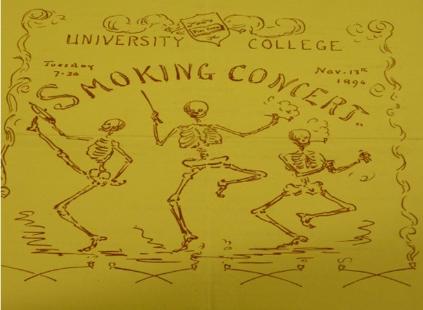
This image comes from one of the smoking concert programmes at University College Liverpool and depicts three smoking skeletons which has more of a poignant relevance for today’s audience than it did in the 1890s. The concerts were held in what is now the Leggate Lecture Theatre at the VG&M.
(Image from University of Liverpool Special Collections and Archives. PUB/3/1)
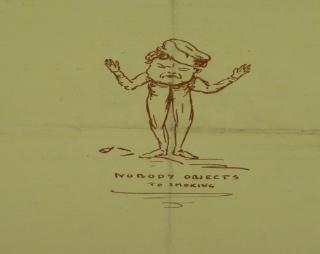
The image above states that ‘Nobody objects to smoking’ and was printed on the back of one of the smoking programmes.
The outbreak of the First World War in 1914 saw massive paper rationing, and in 1916 the Half Holiday comic ceased production. Attempts after the war to revive Sloper proved short-lived, as Sloper was a somewhat stereotypical of the Victorian and Edwardian eras and did not fit into the new post-war world.
In the mid 1970s some comic artists tried to merge the modern fascination with Superheroes with an antiquated Victorian anti-hero and they released 4 issues - but unlike a real superhero, it failed to take flight.
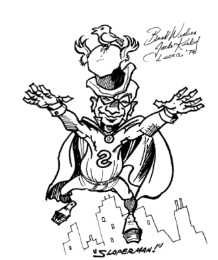
Sloperman as drawn by Jack Kirby in 1976.
The Whole Dam Family
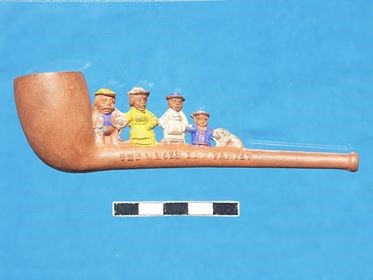
Just like the Ally Sloper Pipe, we have a figurative decoration and a slogan which depicts a play on words. D.A.M is obviously referring to the expletive and although it seems mild by modern standards we must remember that this was a pipe produced for an Edwardian society and the word damn would be classed as religious profanity. In America, the word had previously been censored and so the use of the word in songs and silent films became very popular in the early 1900s (Slide, A. 2007).
Although slightly later than the Ally Sloper Phenomenon, ‘The Whole Dam Family’ also appeared on merchandise like postcards and there are numerous examples that include personalised messages that liken the sender or recipients own families to these popular characters.
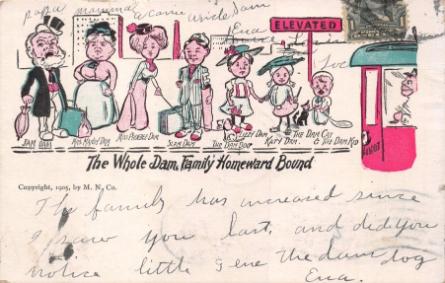
In this example the sender has annotated the postcard with names like “Papa,” “Mama” and “Uncle Sam” and the note reads: “The family has increased since I saw you last and did you notice little (?) the dam dog, Eva.”
In 1905 a comic song called ‘The Whole Dam Family’ was performed by Billy Murray who was a very popular singer in America in the early 20th Century and you can hear a recording on YouTube. In 1915 anther song called 'While The Whol Damm Family Stuck Around' was recorded and we have had the opportunity to record two modern versions of these songs which will be available on the VG&M YouTube Channel from Friday 7 August 2020. You can view the concert programme on this page.
The 1905 song introduces the characters of ‘The Whole Dam Family’ and how they invade the singers flat so that he ends up sleeping on the fire escape with the dog. Although this song sounds comical it has an underlying social message commenting about the financial crisis of this family as the origins of this sketch were based on immigrants coming over to America with their large families. the 1915 song by Clay Phillips gives us a glimpse into dating in the early 1900s whereby a man tries to get close to the daughter without much privacy from her entire family.
The postcards and songs became so popular that the family also appeared in two silent films in 1905 that you can watch on YouTube.
The pictures open with a close view of the individual members of the family and the actors have been styled to look just like the caricature versions from the postcards so that they are easily recognisable to the audience. A short vignette at the end shows the family group seated at dinner and the dog waits until the soup has been served to drag away the table cloth and all the dishes on to the floor which is something even modern audiences would connect with today with funny pets videos on YouTube.
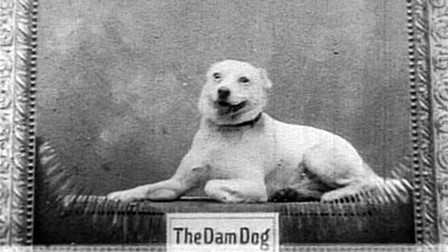
The Dam Dog from the silent film
Just Like Ally Sloper ‘the Whole Dam Family’ became so popular that they were also used in advertising and everyone wanted to own merchandise for the latest craze. They were depicted on postcards right up to the 1940s and more recently, an Australian wine produced in 2015 also used a silent film re-enactment photograph from the 1950s to promote a Heritage wine, which shows that this comedic family can still appeal to modern audiences today.
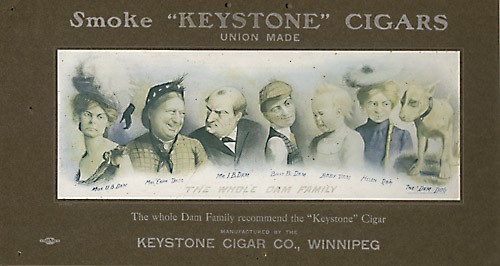
The Keystone Cigar Company stated “The whole Dam Family recommend the Keystone Cigar” and includes the baby showing how standards in advertising have changed over the years and what was once acceptable in society.
There is a lot more than meets the eye when it comes to the clay pipe collection that is on display at the Victoria Gallery and Museum and I hope this article has shown that all objects have a tale to tell.
These two pipes in particular have shown popular fashions and fads that have long since been forgotten about. Although attitudes towards smoking, comedy and society in general may have changed and become outdated since the Victorian era, a modern audience can still appreciate comedy based around family life and will always want to own a piece of merchandise especially with scenarios that resonate with their own lives.

Merchandise for 'Modern Family' which began as a tv show in 2009 and is told from the viewpoint of and unseen documentary filmmaker recording the hilarious perspective of a modern family life, something that we relate to today.
The Ally Sloper pipe is not currently on display but the Whole Dam Family pipe in in the display case in the Tate Hall Museum along with many other highly decorative pipes.
References
Bailey, Peter. “Ally Sloper's Half-Holiday: Comic Art in the 1880s.” History Workshop, no. 16, 1983, pp. 4–31. JSTOR, www.jstor.org/stable/4288498.
Banville, Scott. “‘Ally Sloper's Half-Holiday’: The Geography of Class in Late-Victorian Britain.” Victorian Periodicals Review, vol. 41, no. 2, 2008, pp. 150–173. JSTOR, www.jstor.org/stable/20084241.
Sabin, Roger. “Ally Sloper: The First Comics Superstar?” October 2003. Issue 7. History and Theory of the Graphic Novel special section IAWIS conference, Hamburg 2002, http://www.imageandnarrative.be/inarchive/graphicnovel/rogersabin.htm
Sabin, Roger. "Ally Sloper on Stage." European Comic Art 2.2 2009: pp 205-225.
Slide, Anthony. “Incorrect Entertainment” 2007. BearManor Media.
Special Collections and Archives, University of Liverpool. PUB/3/1 - University College Magazine - 1886-1893
“The Sphinx: University College Student Magazine,” 1893-1993, University of Liverpool, Special Collections and Archives.